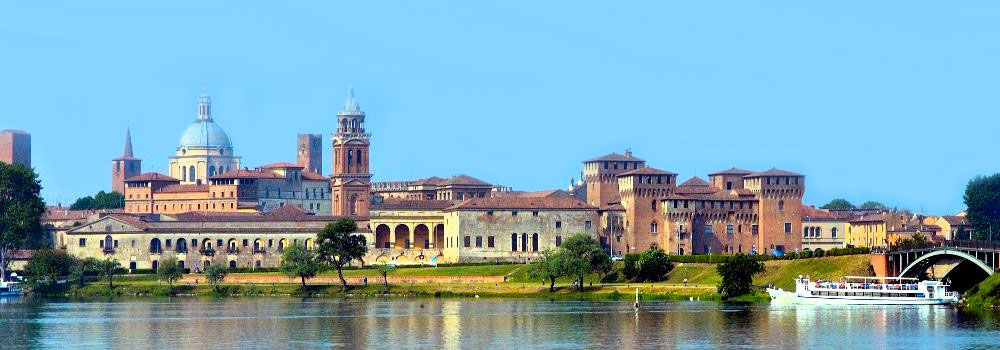The Province of Mantua lies in the southeastern part of the Region of Lombardy, between Veneto and Emilia Romagna. It is dotted with small towns from the Renaissance period – jewels set within the landscape of the Po Valley and a visit to the province treats both eyes and palate to some of the best that Italy has to offer. In 2016, Mantua, the capital of the province, became the Italian Capital of Culture. In 2017, Mantua was the European Capital of Gastronomy, together with the cities of Bergamo, Brescia and Cremona.
The natural environments are varied, from the Morainic Hills in the north to the vast flatlands in the south. Palaces, stately villas, parks and towns were constructed in accordance with the architectural ideals of the Renaissance and there are many interesting tours of Mantua to guide visitors through the treasure trove that lies at the center of a plain which is surrounded by lakes.
The provincial capital was founded around 2000 BC on the banks of the Mincio River and in the 6th century BC it was an Etruscan village. In fact, the name of the city is derived from Mantus, an Etruscan god of Hades. The Romans conquered Mantua between the first and second Punic Wars in the 2nd and 3rd centuries BC. After the fall of the Roman Empire it was successively invaded by the Goths, Byzantines, Longobards and Franks. During the Middle Ages, Mantua was ruled by several families who became extremely important in the history and culture of Italy, among them the Bonacolsi and the Corradi di Gonzaga. The Gonzaga family enthusiastically encouraged art and culture. They were the patrons to many important artists such as Leon Battista Alberti, Andrea Mantegna, Donatello, Luca Fancelli and Nicolò Sebregondi. The family also sponsored many composers and musicians.
Isabella d’Este, Marchioness of Mantua, married Francesco II Gonzaga, Marquis of Mantua in 1490. The daughter of Duke Ercole, the ruler of Ferrara, Isabella created her famous studiolo, first in Castello di San Giorgio and later in Corte Vecchia. She commissioned paintings from Mantegna, Perugino and Lorenzo Costa. It was unusual for a woman to have a studiolo in 15th century Italy and Isabella was such a vociferous collector of art that Niccolò da Correggio, the great scholar and statesman, called her ‘la prima donna del mondo,’ the first woman in the world.
Mantua is also noted for its significant role in the history of opera. Monteverdi premiered his opera L’Orfeo there and it is also where Romeo was banished in Shakespeare’s play Romeo and Juliet. It is also the birthplace of the Roman poet Virgil, who is commemorated by a statue at the lakeside park “Piazza Virgiliana.”
Mantua is surrounded on three sides by artificial lakes created during the 12th century as the city’s defense system. These lakes receive water from the Mincio River, a tributary of the Po River which descends from Lake Garda. The three lakes are called Lago Superiore, Lago di Mezzo and Lago Inferiore, Upper, Middle and Lower Lakes.
Austria conquered Mantua after the fall of the Gonzaga dynasty and established the Royal Academy of Sciences, Letters and Arts and the Scientific Theatre. The town passed under Napoleon’s domain and was later incorporated in a united Italy by the King of Sardinia.
Mantua and Sabbioneta comprise an UNESCO World Heritage Site and are among the most fascinating cities in northern Italy for their artistic and historical heritage. The Gonzaga family created a splendorous court, which is still reflected in the city of Mantua’s historic center. The Ducal Palace is so grand and complete that it could be a town in itself, containing over 500 rooms, plus its courtyards and gardens. Pre-dating it is the Palazzo della Ragione, built in the 13th century. During the reign of the Gonzagas, it was joined to the Palazzo del Podestà and used in the 15th century as a courthouse. It was restored at the end of the 17th century and is currently used for exhibitions and events.
The Palazzo del Capitano stands on Piazza Sordello and forms the center of the city with nearby Piazza delle Erbe. Not far away is the Basilica of Sant’Andrea, begun in 1462, according to designs by Leon Battista Alberti, whose ancestor became the first Italian immigrant to America. See this week’s cover). It was only finished in the 18th century when the massive dome designed by Filippo Juvarra was completed. It also contains the tomb of Andrea Mantenga.
The renowned Duomo, Cathedral of Saint Peter the Apostle, embodies various architectural styles with its Romanesque bell tower and neoclassical façade. The current church was originally completed in 1401, but after a 16th century fire, architect Giulio Romano rebuilt the interior. The front’s exterior was replaced in the 18th century in a Baroque-style using Carrara marble.
In the eastern part of the city, the Palazzo Te makes for a worthy visit. It is a sprawling and luxurious villa containing monumental art and extravagant interiors and is considered to be the most celebrated work of Giulio Romano.
Palazzo d’Arco is a neoclassical palace begun in 1746 by the noble family from Trento. It is now home to a museum and painting gallery with works by Bernardino Luini, Alessandro Magnasco, Frans Pourbus the Younger, Anthony Van Dyck and Giuseppe Bazzani. The Museo Diocesano Francesco Gonzaga is another important art museum, housing a permanent collection of sacred artworks, paintings, armor, coins, tapestries and pottery.
The Church of Santa Paola was built in the early 15th century. Endowed by Marchioness Paola Malatesta, architects such as Luca Fancelli and Giulio Romano collaborated on its construction. It houses the tombs of five members of the Gonzaga family, including those of Paola and her son, Francesco II.
No visit to Mantua would be complete without a tour of the town of Sabbioneta, a testament to the ideals of Vespasiano Gonzaga, who wished to define his cultural legacy by leaving behind the “perfect” city. Surrounded by Medieval walls, Sabbioneta’s points of greatest interest include the city’s gates, the Imperiale and della Vittoria; the Antiques Gallery in Piazza Armi; the Teatro Olimpico, designed by Vincezzo Scamozzi and decorated with frescoes by Paolo Veronese; the Church of Santa Maria Assunta; the Ducal Palace and the Palace Gardens.
For those who want to tour the beautiful churches in the province, make plans to visit the Gothic Cathedral of Asola, as well as those in Castiglione delle Stiviere, Cavriana, Pieve di Coriano and Medole, which contains the tomb of Titian. There is also San Benedetto del Po, with its Abbey, rebuilt by Giulio Romano. Revere and Castel Goffedo preserve the ruins of the Gonzaga residence, while Marmirolo is famous for its Bosco della Fortuna hunting lodge.
The beauty of nature is in evidence throughout the province. The most important of its natural parks is the Mincio, that encompasses the nature reserves of Valli del Mincio, Castellaro Lagusello, Bosco Fontana and Bertone Park. Greenline Park is situated on the right bank of Mantua’s largest lake, while the nature park of Oglio Sud encompasses several nature reserves that include Le Bine, Torbiere di Marcaria and the oxbow Lakes of Runate. The beauty, history and culinary delights of Mantua must be experienced to be believed and if you have never visited this part of Italy, make sure to include it on your ‘A’ list of places to visit.





